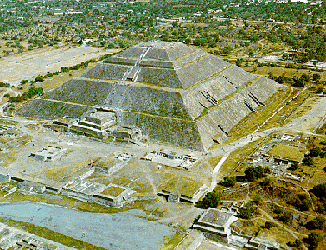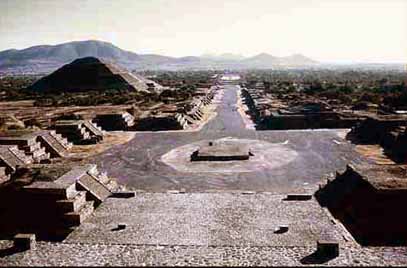
From: http://csc.apolyton.net/scenarios/mexico.shtml
quote:
The Aztecs entered Anáhuac (the Valley of Mexico) in the mid-thirteenth century, but it was not until 1325 when they founded their capital city, Tenochtitlán, in the place where an eagle was sighted killing a snake on a cactus. Gradually the Aztecs transformed their capital from a miserable village of thatched huts to a grand city with adobe houses and stone temples. Paralleling the sophistication of their city, the Aztecs put themselves on the road to empire.
PYRAMID OF THE MOON
From: http://members.cox.net/davehanson/aztec/
quote:
Teotihuacan was an abandoned ghost city by the time the Aztecs found it, and gave it its name, which means "the place where men become gods". No one knows the true name of the city or the people who lived there (who once numbered 200,000). The huge site is laid out on both sides of the "Avenue of the Dead", which was perfectly aligned on a north/south axis. At one end of the avenue was the Plaza of the Moon, surrounded by several flat-topped step pyramids shown in the foreground above. In the background is the large Pyramid of the Moon, which I enjoyed climbing, especially because that end of the site was relatively deserted early in the morning.

PYRAMID OF THE SUN
From: http://www.crystalinks.com/pyrsun_moon.html
quote:
The Pyramid of the Sun, built in the 2nd century AD, dominates the landscape of the ancient city of Teotihuacan in Mexico.
Teotihuacan -the place of the Gods - was the first true city in Mesoamerica, at its peak - 600 AD - it housed more than 100,000 people.
It is the third largest pyramid in the world and the largest in the Teotihuacan complex.
It's sides are 700 feet long, it is about 200 feet high, and is actually a succession of pyramids built one on top the other over the centuries. The pyramids and many other structures at Teotihuacan are stepped, rather than smooth sided like the Egyptian pyramids, and the stones of which they are made are not so large that there would be a mystery about how they were moved as there is with the Egyptian pyramids, the Moai statues of Easter Island, and the Nasca Lines.
At its peak time - most of Teotihuacan was plastered, and the pyramids were painted bright red.
from the same site:

STREET OF THE DEAD
Well, if that gives you the creeps, a bad joke to make up for the deadheadedness...
